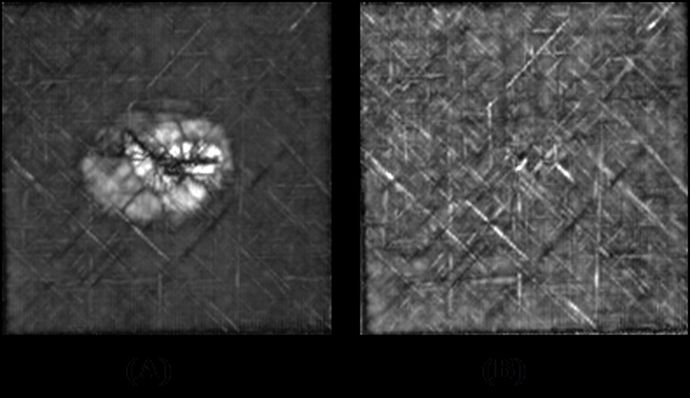Healable Carbon Fiber Reinforced Composites
Mechanical and Fluid Systems
Healable Carbon Fiber Reinforced Composites (LAR-TOPS-136)
Puncture- healing thermoplastic resin carbon fiber reinforced composites towards more damage/impact tolerant systems
Overview
NASA Langley Research Center has developed carbon fiber reinforced composites with self-healing properties. The initiation and propagation of damage to carbon composites, such as in aircraft structural components, results in component failure. Typical structural repairs result in damaging practices, where material is ground away and holes are drilled to secure patches, which can act as new sites for damage. This technology exhibits effective self-repair that heals quickly following low to mid velocity impacts, while retaining structural integrity.
The Technology
A composite fabrication process cycle was developed from composite precursor materials developed at LaRC to fabricate composite laminates. The precursor material is a pre-impregnated unidirectional carbon fiber preform, or prepreg. In the pre-pregging process, the high strength, structural reinforcing carbon fiber is wetted by a solution containing a self-healing polymer. The resulting material is of aerospace quality and exhibits a significant decrease of internal damage following impacts tests (using ASTM D 7137 standard).


Benefits
- Healable system following low to mid velocity impacts
- Aerospace quality carbon fiber composites
- Extends life of typical carbon fiber components
- Self-healing properties do not require microcapsules, which can act as defect initiators
Applications
- Aircraft
- Rotocraft
- Spacecraft
- Missiles
Technology Details
Mechanical and Fluid Systems
LAR-TOPS-136
LAR-18131-3
PROCESSING AND DAMAGE TOLERANCE OF CONTINUOUS CARBON FIBER COMPOSITES CONTAINING PUNCTURE SELF-HEALING THERMOPLASTIC MATRIX. Brian W. Grimsley, Keith L. Gordon, Michael W. Czabaj, Roberto J. Cano, and Emilie J. Siochi. SAMPE 2012, May 21-24, 2012. https://ntrs.nasa.gov/citations/20120009199
FRACTURE TOUGHNESS OF CARBON FIBER COMPOSITES CONTAINING VARIOUS FIBER SIZINGS AND A PUNCTURE SELF-HEALING THERMOPLASTIC MATRIX. Roberto J. Cano, Brian W. Grimsley, James G. Ratcliffe,Keith L. Gordon, Joseph G. Smith Jr., and Emilie J. Siochi. CAMX 2015: The Composites and Advanced Materials Expo. https://ntrs.nasa.gov/citations/20160006366
FRACTURE TOUGHNESS OF CARBON FIBER COMPOSITES CONTAINING VARIOUS FIBER SIZINGS AND A PUNCTURE SELF-HEALING THERMOPLASTIC MATRIX. Roberto J. Cano, Brian W. Grimsley, James G. Ratcliffe,Keith L. Gordon, Joseph G. Smith Jr., and Emilie J. Siochi. CAMX 2015: The Composites and Advanced Materials Expo. https://ntrs.nasa.gov/citations/20160006366
Similar Results

Continuous Fiber Composite for Use in Gears
Designers are constantly seeking to improve the power-to-weight ratio of components in rotorcraft and other flight vehicles. One approach has involved using lightweight carbon fiber composite materials to replace gear web portions and other components that are typically made from steel. The problem with using fiber composite materials comes when more complex shapes are required. To create thickness variation and other accommodations for complex shapes, manufacturers can stack cut continuous fiber plies and/or form short, fiber-reinforced composite material to the desired shape. Unfortunately, these methods leave cut fiber ends within the structure, which often become initial sites for high cycle fatigue damage in high speed, high power density applications. Glenn's new method tackles this problem with one of three approaches. The first approach is applicable to gears that are planar in shape and have a single hub and a single rim. The hub and web sections of the gear are made as an integrated structure with decreased thickness from the hub inner diameter to the web outer diameter. The thickness variation is accomplished using multiple layers of continuous fiber composite material formed to specific shapes and separated by filler materials. The second approach is applicable to gears that have an extended gear body in the axial direction rather than a simple planar structure. In this approach, the gear body is made using multiple layers of continuous fiber composite material in the shape of a solid of revolution. The third approach is a power transfer assembly made by combining approaches one and two. With any of these three approaches, the material can be tailored to the structure by the properties of fibers used, the number of fiber layers used, and the location of the fibers relative to the neutral axis of the structure. Glenn's innovation opens the door for carbon fiber composite materials to be used for many applications for which they were previously unsuited.

Vertically Aligned Carbon Nanotubes
Formation of the inventive polymer composite matrix begins by growing carbon nanotubes directly on a veil substrate. The carbon nanotubes are grown from both sides of a non woven carbon fiber mat. The carbon nanotubes can be single or multi walled and can be grown to predetermined lengths. The veiled substrate is positioned between carbon fiber/ polymer prepreg layers such that the carbon nanotubes protrude into the reinforcement layers. The polymer composite matrix formed following curing of the resin exhibits improved interlaminar strength, fracture toughness and impact resistance. Because of the thinness of the veil layer, electricity can pass from conductive carbon nanotubes on one side of the veil to conductive carbon nanotubes on the other side of the veil. Electricity can also pass between two veils intercalated into the same reinforcement layer when the length of the nanotubes is sufficiently long enough to provide overlap within the reinforcement layers.

Multi-layered Self-healing Material System for Impact Mitigation
This innovation utilizes a tri-layered structure, comprised of solid plastic front and back layers sandwiching a viscous, reactive liquid middle layer. Combined, this system provides rapid self-healing following high velocity ballistic penetrations. Self-healing in the front and back layers occurs when the puncture event creates a melt state in the polymer materials and the materials melt elasticity snaps back and closes the hole. The viscous middle layer augments the self-healing properties of the other layers by flowing into the gap created by a ballistic puncture and concurrently solidifying due to the presence of oxygen. Thus, this innovation has two tiers of self-healing: a puncture-healing mechanism triggered by the projectile and a second mechanism triggered by the presence of oxygen.

Puncture-healing Engineered Polymer Blends
Puncture healing melt blends were developed by melt blending self-healing polymers with non self-healing polymeric materials. The self-healing polymeric materials consisted of Surlyn® 8940, Affinity™ EG 8200 G, and poly(butadiene)-graft-poly(methyl acrylate-co-acrylonitrile) or Barex® 210 IN. The non-self-healing polymeric materials consisted of poly(ether ether ketone) (PEEK), LaRC phenyl ethynyl terminated imide 330 (LaRC PETI 330), and Raptor Resins Bismaleimide-1 (BMI-1). Puncture healing blends were also prepared with chopped glass and chopped carbon fibers. The overall goal was to develop a product with superior properties relative to either of the starting materials. The melt blends were prepared in varying compositions to optimize desired properties of the resulting matrix. Ballistic testing was conducted to determine the self-healing characteristics of several developmental polymers subjected to micrometeoroid type damage.

Carbon Fiber-Carbon Nanotube Yarn Hybrid Reinforcement
NASA's new material is a toughened triaxial braid made from ductile carbon nanotube (CNT) yarn hybridized with carbon fiber, which is ultimately used as reinforcement material to make toughened polymer matrix composites. The CNT yarn component of the reinforcement is solely responsible for adding toughness, while the processes used to optimize the fiber braiding parameters and tensile properties of the carbon fiber-CNT yarn hybrid tow material determine the overall improvement in tensile strength for resin impregnated fiber tows. Bundles of continuous carbon nanotube yarns are combined with a similar format of carbon fiber, yielding an easily scalable process.
Advantages of the material include reduced cost by eliminating use of toughening agents, increased ability to conform to highly complex geometries, greater environmental stability compared to aramid fiber reinforcements such as Kevlar, and possibly decreased density. Many hybrid reinforcements exhibit interfacial compatibility issues, which could lead to premature failure via crack propagation at the polymer matrix interface. In contrast, chemical similarities between the CNT yarn and carbon fiber constituents impart NASA's hybrid reinforcement material with excellent interfacial compatibility.
Potential applications include aerospace components, composite pressure vessels, wind turbine blades, automotive components, prosthetics, sporting equipment, construction reinforcement material, and other use-cases where strength-to-weight ratio is of utmost importance.



